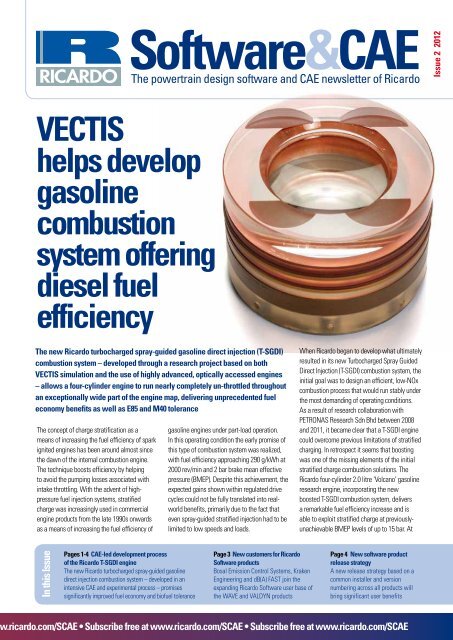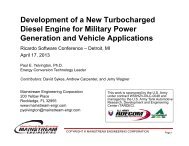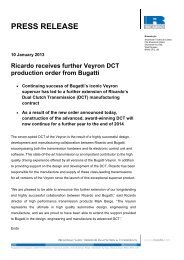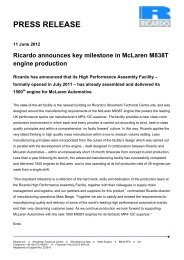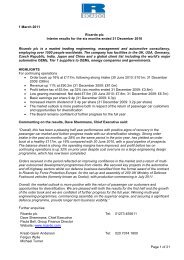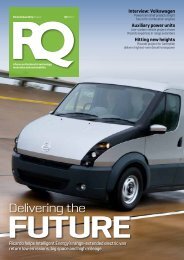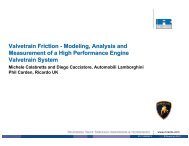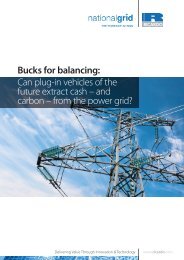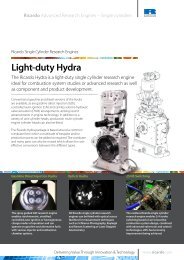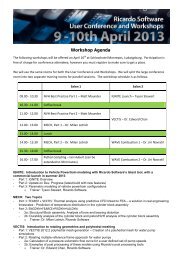Issue 2 2012 - Ricardo
Issue 2 2012 - Ricardo
Issue 2 2012 - Ricardo
You also want an ePaper? Increase the reach of your titles
YUMPU automatically turns print PDFs into web optimized ePapers that Google loves.
Software&CAE<br />
The powertrain design software and CAE newsletter of <strong>Ricardo</strong><br />
<strong>Issue</strong> 2 <strong>2012</strong><br />
VECTIS<br />
helps develop<br />
gasoline<br />
combustion<br />
system offering<br />
diesel fuel<br />
efficiency<br />
The new <strong>Ricardo</strong> turbocharged spray-guided gasoline direct injection (T-SGDI)<br />
combustion system – developed through a research project based on both<br />
VECTIS simulation and the use of highly advanced, optically accessed engines<br />
– allows a four-cylinder engine to run nearly completely un-throttled throughout<br />
an exceptionally wide part of the engine map, delivering unprecedented fuel<br />
economy benefits as well as E85 and M40 tolerance<br />
The concept of charge stratification as a<br />
means of increasing the fuel efficiency of spark<br />
ignited engines has been around almost since<br />
the dawn of the internal combustion engine.<br />
The technique boosts efficiency by helping<br />
to avoid the pumping losses associated with<br />
intake throttling. With the advent of highpressure<br />
fuel injection systems, stratified<br />
charge was increasingly used in commercial<br />
engine products from the late 1990s onwards<br />
as a means of increasing the fuel efficiency of<br />
gasoline engines under part-load operation.<br />
In this operating condition the early promise of<br />
this type of combustion system was realized,<br />
with fuel efficiency approaching 290 g/kWh at<br />
2000 rev/min and 2 bar brake mean effective<br />
pressure (BMEP). Despite this achievement, the<br />
expected gains shown within regulated drive<br />
cycles could not be fully translated into realworld<br />
benefits, primarily due to the fact that<br />
even spray-guided stratified injection had to be<br />
limited to low speeds and loads.<br />
When <strong>Ricardo</strong> began to develop what ultimately<br />
resulted in its new Turbocharged Spray Guided<br />
Direct Injection (T-SGDI) combustion system, the<br />
initial goal was to design an efficient, low-NOx<br />
combustion process that would run stably under<br />
the most demanding of operating conditions.<br />
As a result of research collaboration with<br />
PETRONAS Research Sdn Bhd between 2008<br />
and 2011, it became clear that a T-SGDI engine<br />
could overcome previous limitations of stratified<br />
charging. In retrospect it seems that boosting<br />
was one of the missing elements of the initial<br />
stratified charge combustion solutions. The<br />
<strong>Ricardo</strong> four-cylinder 2.0 litre ‘Volcano’ gasoline<br />
research engine, incorporating the new<br />
boosted T-SGDI combustion system, delivers<br />
a remarkable fuel efficiency increase and is<br />
able to exploit stratified charge at previouslyunachievable<br />
BMEP levels of up to 15 bar. At<br />
In this <strong>Issue</strong><br />
Pages 1-4 CAE-led development process<br />
of the <strong>Ricardo</strong> T-SGDI engine<br />
The new <strong>Ricardo</strong> turbocharged spray-guided gasoline<br />
direct injection combustion system – developed in an<br />
intensive CAE and experimental process – promises<br />
significantly improved fuel economy and biofuel tolerance<br />
Page 3 New customers for <strong>Ricardo</strong><br />
Software products<br />
Bosal Emission Control Systems, Kraken<br />
Engineering and dB(A) FAST join the<br />
expanding <strong>Ricardo</strong> Software user base of<br />
the WAVE and VALDYN products<br />
Page 4 New software product<br />
release strategy<br />
A new release strategy based on a<br />
common installer and version<br />
numbering across all products will<br />
bring significant user benefits<br />
.ricardo.com/SCAE • Subscribe free at www.ricardo.com/SCAE • Subscribe free at www.ricardo.com/SCAE
Gasoline combustion<br />
the “classic” 2000 rev/min 2 bar BMEP point the<br />
brake specific fuel consumption (BSFC) of the lean<br />
stratified T-SGDI engine was measured at only<br />
277.5 g/kWh versus 370 g/kWh in homogenous<br />
lambda 1 mode. However, with 10 bar BMEP and<br />
40 Nm torque the BSFC falls to a diesel-like 206<br />
g/kWh. At 2500 rev/min the T-SGDI engine even<br />
beats the BSFC levels of a benchmark EU5 fourcylinder<br />
1.6 litre diesel engine.<br />
CAE-led development process<br />
In order to provide a simulation toolchain<br />
capable of engineering production<br />
implementations of the new T-SGDI combustion<br />
system, it was necessary to develop and<br />
validate a process capable of reliably simulating<br />
the firing engine under normal operation. The<br />
first stage of the process is to characterize<br />
the spray structure from the chosen injector<br />
and injection strategy. <strong>Ricardo</strong> has worked<br />
in partnership with both Cardiff and Brighton<br />
Universities over many years to develop a<br />
standardised laser diagnostics rig that is used<br />
as the basis for this work. The rig consists<br />
of an optically accessed chamber into which<br />
the injector fires. Measurements are typically<br />
carried out at both ambient conditions as well<br />
as at elevated pressures and temperatures more<br />
typical of those found in an operating engine.<br />
For most experimental processes an injector<br />
firing frequency of around 10 Hz is used in order<br />
to enable averaging between a large number of<br />
injections as well as processing of coefficient of<br />
variation data for critical readings.<br />
“Validating a detailed VECTIS spray model of<br />
the selected injector is the first step in being<br />
able to simulate the operation of a new form of<br />
combustion system,” said <strong>Ricardo</strong> CAE manager<br />
James Mullineux. “We are not in the business of<br />
developing new gasoline injectors but we need to<br />
have a robust means of simulating the very latest<br />
technologies available for engine design. As such,<br />
direct validation of our spray models for each new<br />
injector type is an essential first step. In this case<br />
the rig enabled us to tune our VECTIS models to<br />
match the actual fuel spay structure – including<br />
droplet formation, coalescence, and break-up,<br />
evaporation and penetration – from the selected<br />
injectors under a range of conditions.”<br />
As the T-SGDI combustion system concept was<br />
itself a fresh innovation, an additional step<br />
was taken in the research programme to<br />
validate the CAE simulation process. A singlecylinder<br />
optical research engine was built at the<br />
University of Brighton for the research<br />
project. Possibly the most advanced<br />
of its type in the world, this provides a much<br />
greater optical access than previous designs,<br />
with superior vision into the cylinder, particularly<br />
around the spark plug. It has crystal clear optics<br />
thanks to a quartz optical cylinder liner which,<br />
uniquely for an engine of this type, protrudes into<br />
the combustion chamber thanks to a specially<br />
developed cylinder head gasket system. The<br />
lower part of the engine has a conventional style<br />
connecting rod and piston with oil scraper rings<br />
running in a conventional cast iron bore to keep<br />
the lubricating oil in the crankcase.<br />
The optical ‘half’ of the engine sits on top of<br />
this assembly, a hollow titanium connecting<br />
rod attaching the lower piston to the upper<br />
piston, which itself has a unique upper design<br />
incorporating a quartz crown with bowl and valve<br />
cut outs. Also incorporated in the piston’s quartz<br />
crown is a fish-eye lens giving a very clear view<br />
of the combustion process. The piston itself is<br />
a composite, with the quartz crown bonded to<br />
a ceramic base using an epoxy glue. A mirror<br />
gives a clear view vertically upwards into the<br />
Spray imaging<br />
Spray PDA testing<br />
A standardised laser diagnostics rig is used to<br />
understand fuel injection characteristics and to<br />
validate initial VECTIS models (above). Given<br />
the fundamentally new nature of the <strong>Ricardo</strong><br />
T-SGDI combustion system, an advanced optically<br />
accessed engine (cover page and below left) was<br />
used as a further means of experimental validation<br />
of CAE models (below/above right), prior to CAEled<br />
optimization of the design<br />
combustion chamber by looking in from the side<br />
of the engine, the optical piston running ‘dry’<br />
in the quartz bore. The cylinder head is black<br />
anodised to prevent reflection of the lasers<br />
and the engine can operate to a peak cylinder<br />
pressure of 70 bar.<br />
“The optical engine provided a further extremely<br />
important step in the CAE simulation process,”<br />
continues Mullineux, “allowing us visual access<br />
to the combustion chamber during fuel injection<br />
and mixing, enabling us to further validate<br />
our VECTIS and WAVE models. Clearly the<br />
combustion chamber geometry was not the same<br />
as that in the metal engine – as the piston crown<br />
has a bowl shape forming the upper surface of<br />
the fish-eye lens – but this provided an extremely<br />
useful further step in the validation process,<br />
allowing the VECTIS and WAVE simulation<br />
to help drive forward the development of the<br />
research engine.”<br />
One of the key aspects of the T-SGDI combustion<br />
system is the use of a multiple injection strategy.<br />
Whereas this approach is used effectively in<br />
2 <strong>Ricardo</strong> Software & CAE • <strong>Issue</strong> 2 <strong>2012</strong>
Gasoline combustion<br />
modern diesels to control combustion rate, the<br />
T-SGDI combustion system uses multiple injections<br />
to limit spray penetration and hence avoid wall<br />
wetting. If optimized appropriately across a wide<br />
range of operating conditions, as in the T-SGDI<br />
system, the approach allows a stoichiometric<br />
mix to be focused in the region of the spark<br />
plug immediately prior to ignition. In addition to<br />
enabling fuel economy benefits to approach the<br />
theoretical optimum through unthrottled operation,<br />
the concept also offers enhanced EGR tolerance<br />
and is inherently low NOx.<br />
With VECTIS simulation used to refine key aspects<br />
of the combustion system, further work was<br />
carried out in parallel using a thermodynamic<br />
single-cylinder engine to investigate the effects of<br />
multiple injection strategies and boosting upon fuel<br />
consumption, emissions and combustion stability.<br />
Finally, a fully functional four-cylinder <strong>Ricardo</strong><br />
Volcano gasoline engine was tested to validate<br />
the single-cylinder engine and CAE results, and to<br />
undertake further emissions development. As the<br />
number of combustion parameters is exceptionally<br />
high at over 40 variables, an in-house developed<br />
Design of Experiments (DoE) and objective<br />
optimization suite was used during T-SGDI engine<br />
development.<br />
Anatomy and operation of the<br />
Volcano engine<br />
The four-cylinder 2.0 litre Volcano engine has<br />
a bore and stroke of 86 mm, with a nominal<br />
compression ratio of 10.7:1. It has twin cam<br />
phasers for variable valve timing (VVT) and a<br />
Garrett Fixed Geometry Turbocharger to provide<br />
high specific performance. For the T-SGDI<br />
combustion system development, four different<br />
types of injector technology were investigated,<br />
including piezoelectric and solenoid types.<br />
At 197 kW and 391 Nm of torque, the engine<br />
is strong enough to offer the generous level of<br />
power for a D-segment car typically found in<br />
Europe or North America. However, the T-SGDI<br />
technology has been developed to be scalable<br />
down to a 72 mm bore. The standard fuel is 95<br />
RON unleaded gasoline, but the injection process<br />
also works stably with alternative fuels up to E85<br />
and M40 blends.<br />
Much like a diesel engine, the T-SGDI engine<br />
runs almost completely unthrottled, with excess<br />
air (up to 4500 rev/min) and with the driver’s load<br />
request translated into the injected fuel quantity.<br />
Depending on the load request, the size of the λ1<br />
air-fuel mix zone is varied from stratified to a fully<br />
stoichiometric mix throughout the combustion<br />
chamber. From stable idling at an air-fuel ratio<br />
of 160:1 (λ>10) to a boosted mid load at up to 15<br />
bar BMEP, the stratified charge is surrounded by<br />
excess air and/or residual gas.<br />
By expanding boosted and stratified operation,<br />
the T-SGDI engine offers the combined benefits of<br />
downsizing and minimum fuel injection. The multicylinder<br />
engine demonstrated that fuel consumption<br />
benefits were significantly enhanced through<br />
boosting, with a best BSFC of 203 g/kWh being<br />
achieved at 2250 rev/min and 13 bar BMEP. The<br />
higher mass flow during part load resulting from<br />
New customers<br />
Bosal ECS joins the<br />
WAVE user base<br />
Bosal Emission Control Systems supplies<br />
solutions for emission controls, energy<br />
management and sound design to<br />
customers in the automotive and off road<br />
market. Bosal´s customer base includes<br />
all major car manufacturers worldwide<br />
as well as a variety of leading industrial<br />
conglomerates.<br />
“I’m very excited with the addition of<br />
WAVE/WaveBuild3D to our simulation<br />
portfolio,” said Filip Dörge, manager<br />
Acoustical Engineering. “It strengthens<br />
further our position to supply optimal and<br />
innovative solutions within a reduced<br />
lead-time in a highly collaborative OEM<br />
environment.”<br />
Established in 1923 in Alkmaar, the<br />
Bosal Group and its ECS division are<br />
headquartered in Lummen, Belgium. For<br />
more information visit: www.bosal.com<br />
Kraken Engineering joins<br />
VALDYN user base<br />
Kraken Engineering is a consultancy<br />
business based in Belgium with<br />
extensive professional experience in both<br />
measurement and simulation, especially<br />
– but not exclusively – as applied to<br />
powertrains. For more information visit:<br />
www.kraken-eng.com<br />
dB(A) FAST selects<br />
WAVE<br />
Acoustic simulation specialist dB(A) FAST<br />
was founded this year by ex-Faurecia NVH<br />
specialist Roger Chuter to provide NVH and<br />
back-pressure support to the automotive<br />
and aerospace Industries. The company is<br />
the latest addition to the rapidly expanding<br />
WAVE user base. For more information visit:<br />
www.dba-fast.vpweb.co.uk<br />
<strong>Issue</strong> 2 <strong>2012</strong> • <strong>Ricardo</strong> Software & CAE 3
Gasoline combustion<br />
unthrottled operation also improves turbocharger<br />
response. In addition, the best BSFC engine map<br />
areas are much closer to real-world requirements<br />
than is the case with previous stratified charge<br />
solutions. Unlike a diesel engine, there is no<br />
practical smoke-limited AFR, so lambda can be<br />
instantaneously switched from lean to λ1 or richer<br />
to maximize the air utilization for maximum torque<br />
and increased enthalpy release to the turbine for<br />
enhanced run-up.<br />
New release strategy<br />
<strong>Ricardo</strong> Software has begun to roll out a<br />
common release strategy across its entire<br />
product range, which promises greater ease of<br />
use to customers. Each of the major products –<br />
WAVE, VECTIS, FEARCE, VALDYN, ENDGYN – is<br />
typically dependent upon one or more additional<br />
utility programs, including RPlot, SDFBrowser,<br />
R-Desk, ISIS and the license management<br />
software. As a result there are many different<br />
permutations of products and utility software<br />
required by different users, all of which are<br />
subject to periodic updates.<br />
With the consequent complexity of the update<br />
and installation process, it has been decided<br />
to combine all product releases under a single<br />
Further potential<br />
The <strong>Ricardo</strong> T-SGDI engine shows the promise of<br />
further progress by improving its robustness to even<br />
higher diluents. Recent work with a re-optimized<br />
single-cylinder research engine with revised ignition<br />
system has shown brake specific fuel consumption<br />
of less than 200 g/kWhr. The challenge, however,<br />
will be to maintain this high level of efficiency whilst<br />
meeting future US LEV 3 emissions requirements.<br />
By applying a Miller cycle to reduce compression<br />
<strong>Ricardo</strong> T-SGDI ‘Volcano’ engine fuel consumption map and operating strategy<br />
Red region:<br />
•WOT • boosted<br />
region<br />
•Combination • of<br />
closed space late<br />
injections and<br />
MIVIS strategy<br />
•EGR • 0-10%<br />
Best BSFC<br />
achieved<br />
at mid load<br />
under boosted<br />
conditions. With<br />
this concept it<br />
could be possible<br />
to over downsize<br />
or downspeed<br />
the engine<br />
dependant<br />
on vehicle<br />
application<br />
Lower speed best BSFC island limited by<br />
achievable boost pressure – rematching of the<br />
T/C should improve this<br />
Remaining region:<br />
•Lambda • 1.4-1 operating<br />
region, no EGR required<br />
Grey region:<br />
•Lambda • 1 operating<br />
region with multiple<br />
injection strategies for<br />
knock mitigation<br />
•Low • pressure cooled<br />
WOT EGR (5-15%) can<br />
be used when combined<br />
with advanced boosting<br />
and increased CR<br />
for further efficiency<br />
improvements<br />
Green region:<br />
•WOT • Boosted region<br />
•MIVIS • strategy for<br />
best BSFC<br />
•EGR • 0% as "off cycle"<br />
Blue region:<br />
•WOT • (effectively) NA stratified region<br />
•All • late, close spaced multiple injections<br />
•EGR • 10-30% dependant on engine out<br />
NOx target<br />
structure and numbering system, together with a<br />
new and unified installer utility. All users will use<br />
exactly the same installer software and simply<br />
select the products they require, thus providing<br />
a higher level of automation and considerably<br />
simplifying the installation process.<br />
Roll-out of the new, easy-to-use installer<br />
software – which will have the same look and<br />
feel across both Windows and Linux platforms<br />
– has already started, with all products aligning<br />
on the new common version numbering of ‘Year.<br />
Release Number’ over the coming months. The<br />
sole exception to the new arrangements will be<br />
the SABR product, as its development continues<br />
outside <strong>Ricardo</strong> Software.<br />
temperatures and increase expansion ratio, there<br />
may also be additional potential to further increase<br />
the tolerance to knocking.<br />
A significant aspect of the achievement of the<br />
T-SGDI research project has been the ability to<br />
produce validated VECTIS models of the combustion<br />
system that can be used to provide a truly predictive<br />
assessment of the engine under operation. While<br />
the approach used on the research project included a<br />
CFD correlation exercise both with the spray rig and<br />
an optically accessed engine, the latter would, as<br />
Mullineux concludes, not be necessary as part of a<br />
production CAE process:<br />
“The fuel spray rig will always be a crucial part<br />
of the CAE tool chain as we need to understand<br />
the capabilities, characteristics and performance<br />
of each new type of injector. However, having<br />
carried out this level of fine-tuning and validation<br />
of the spray models, we already have a high<br />
degree of confidence that VECTIS – coupled with<br />
WAVE to provide intake and exhaust boundary<br />
conditions – is capable of reliable in-cylinder<br />
simulation for any operating point under<br />
investigation. As such, we have a highly efficient<br />
and cost-effective CAE methodology that can<br />
now be applied in the development of production<br />
implementations of this type of advanced and<br />
highly fuel-efficient combustion technology.”<br />
Conference success in <strong>2012</strong><br />
<strong>Ricardo</strong> Software has had its most successful year<br />
to date in terms of user conferences, with events<br />
hosted in the United States, Japan, India, Germany<br />
and Turkey attracting a wide range of speakers and<br />
over 360 delegates from across the user base.<br />
“User conferences are an important part of<br />
our business,” commented <strong>Ricardo</strong> Software<br />
president Dave Higbie. “They provide a highly<br />
valuable forum in which new application<br />
experiences can be shared between users from<br />
different companies, and plans for new features<br />
discussed with software developers. Following<br />
our best year to date we are committed to doing<br />
even better in the year ahead – I look forward to<br />
welcoming even more of our customers to our<br />
user conferences in 2013.”<br />
For further information about <strong>Ricardo</strong><br />
Software productions and support services,<br />
please contact:<br />
Software Sales:<br />
Software Support:<br />
Or visit<br />
RS_Sales@ricardo.com<br />
RS_Support@ricardo.com<br />
www.ricardo.com<br />
Subscribe free at www.ricardo.com/SCAE • Subscribe free at www.ricardo.com/SCAE • Subscribe free at www


